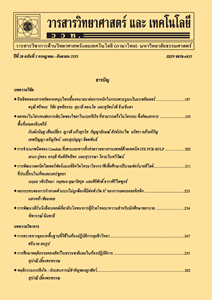การกำจัดสปอร์ของ Bacillus subtilis ในน้ำด้วยปฏิกิริยาโฟโตคะตะไลสิสจากการใช้ผงและแผ่นกรองจุ่มเคลือบผงไทเทเนียมไดออกไซด์
Main Article Content
Abstract
The aim of this study was to inactivate spores of Bacillus subtilis in water using TiO2 photocatalyst under sunlight irradiation for a duration of 180 min. Two forms of TiO2 were used, Degussa P25 powder in a concentration of 0.001 to 0.05 g/L and Degussa P25 dip-coated filter. Since Degussa P25 powder is suspended in water, its elimination after treatment is very difficult. This research, thus, used a dip-coating technic to fix Degussa P25 onto a filter. Polyethylene glycol molecular weights of 1,000 to 6,000 were used as a binder in a concentration of 1.5 to 25 mg/mL, while the concentrations of Degussa P25 were 1, 3, and 5 wt%. The results showed that a 0.005 g/L of Degussa P25 powder was the most efficient condition to inactivate the spores (100 % efficiency) within 120 min. For the coated filter, 1 wt% of Degussa P25 and 20 mg/mL of PEG molecular weight of 2000 (TiO2 concentrations of 0.6-1 g/L) gave the best inactivation rate (100 % efficiency) within 180-240 min. However, increase the number of coated filter did not enhance the inactivation efficiency. Since the filter in this study was too thick, the sunlight could not thoroughly penetrate, consequently uneven free radicals were generated. Thus, part of the filter with less radicals could be a place for the microbes to hide. The results from this study can be applied to any water disinfection.
Article Details
References
[2] Wang, L.S., Wei, D.B., Wei, J. and Hu, H.Y., 2007, Screening and estimating of toxicity formation with photobacterium bioassay during chlorine disinfection of waste water, J. Hazard. Mater. 141: 289-294.
[3] Macauley, J.J., Qiang, Z., Adams, C.D., Surampalli, R. and Mormile, M.R., 2006, Disinfection of swine wastewater using chlorine, ultraviolet light and ozone, Water Res. 40: 2017-26.
[4] Betancourt, W. and Rose, J.B., 2004, Drinking water treatment processes for removal of Cryptosporidium and Giardia, Vet. Parasitol. 126: 219-34.
[5] EPA Victoria 2002, Guidelines for Environ Mental Management: Disinfection of Treated Wastewater, Available Source: www.epa.vic.gov.au/~/media/Publications/730.pdf, January 4, 2017.
[6] Shon, H.K., Phuntsho, S., Okour, Y., Cho, D.L., Kim, J.B., Na, S., et al., 2008, Visible light responsive titanium dioxide (TiO2): A review, Appl. Chem. Eng. 19: 1-16.
[7] Sunada, K., Kikuchi, Y., Hashimoto, K. and Fujishima, A., 1998, Bactericidal and detoxification effects of TiO2 thin film photocatalysts, Environ. Sci. Technol. 32: 726-728.
[8] Nawarat, S., Supothina, S. and Chuay bamroong, P., 2010, Removal of Bacillus subtilis from wastewater using photocatalysis and ultraviolet-C, Thai Environ. Eng. J. 24(3): 33-42. (in Thai)
[9] Pelizzetti, E., Pramauro, E., Minero, C. and Serpone, N., 1990, Sunlight photocatalytic degradation of organic pollutants in aquatic systems, Waste Manag. 10: 65-71.
[10] Murakami, Y., Endo, K., Ohta, I., Nosaka, A.Y. and Nosaka, Y., 2007, Can OH radicals diffuse from the UV-irradiated photocatalytic TiO2 surface? Laser-induced-fluorescence study, J. Phys. Chem. C 111: 11339-11346.


